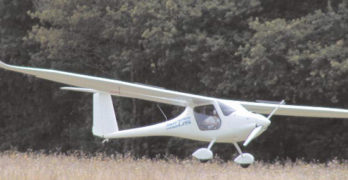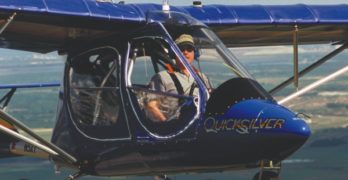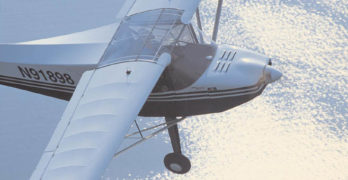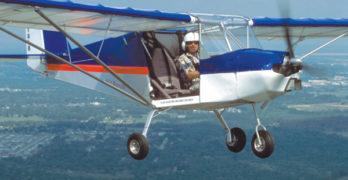Many excellent aircraft may be headed our way
Parlez-vous Française? Sprechen Sie Deutsche? Parlate Italiano? Fortunately, to understand European recreational aircraft you don’t need to speak French, German, or Italian. Yet the light-sport aircraft (LSA) that may interest you could come from countries where the mother tongue isn’t English.
Welcome to the globalized
world of light-sport
aircraft where the workers
who built your plane may speak
Polish, Russian, Hungarian, or
Latvian in addition to French,
German, or Italian.
Though many intriguing
ultralights come from Europe and
Americans have seen a few of these,
many are a complete surprise to
Yankee pilots. That will change.
Last year after EAA AirVenture
Oshkosh 2002 ended, I traveled to
Blois (pronounced Blwah), France, a
town about 200 kilometers south of
Paris. There I attended the 22nd
salon (or air show) that organizers
present at this location each year in
late summer. Let’s take a walk
around the salon at Blois.
Search Results for : Part 103
Not finding exactly what you expected? Try our advanced search option.
Select a manufacturer to go straight to all our content about that manufacturer.
Select an aircraft model to go straight to all our content about that model.
First to Achieve Light-Sport Aircraft Status?
Discounting coordination qualities, steep turns, well, all turns went very well in the GT 500; it is very precise in handling. You can always point the plane where you wish.
Many pilots, especially those trained in general aviation aircraft, love the yoke. I much prefer a joystick. This is personal preference, but you can’t fault the execution of the yoke arrangement in the GT 500. Like all components, it’s very well done.
Since I’d just flown the Flight Design CT before the
GT 500, comparisons were easy. Handling in the composite CT aircraft was much more fluid (though that may not suit everyone). The CT could also fly nearly as slowly over the fields as the GT 500, showing the possibilities in new aircraft designs.
The GT 500 behaved very properly at speed. Cruising at 90 mph indicated, the design felt very solid and gave every assurance. However, at 4,200 rpm and 50 to 55 mph, I experienced almost a continuous shudder that seemed to come from the tail.
Rans S-6S Coyote II
As the dawn of the sport pilot rule changes approaches,
Kansas-based RANS Inc. is one of the
most successful kit aircraft manufacturers in the
light aviation industry.
Randy Schlitter, RANS’ boss and founder, is now a seasoned
veteran of the kit airplane business. Over his
years in business, he has created several popular aircraft
designs that have found favor in the United
States, Europe, and about 50 other countries around
the globe.
Of the broad RANS line, the one model that has most revved up
buyers is the S-6S Coyote II. Despite competition from hundreds of
other aircraft, the Coyote line has sold an impressive fleet of 1,500 aircraft. The single-place version, S-4/5, first
flew 20 years ago and has also sold reasonably
well, but it is the Coyote II that
has become the single most successful
RANS design.
The two-place Coyote II is available in
two models—the S6-S and the S-6ES.
Sportstar Sidebar
Why Buy this Plane over Another?
I asked the question of U.S. dealer James Peeler. He’s been a Flightstar dealer and pilot for several years and is “one of us” ultralight pilots. Now that he represents the Czech aircraft, he should be able to relate why the model excites him.
The EV-97 EuroStar aka SportStar has been manufactured for more than 6 years in the Czech Republic and has been used as a trainer in Europe without even one service bulletin or airworthiness directive issued, Peeler says. The factory has achieved the ISO 9001 quality standard certification.
More pragmatically, Peeler says, “The plane flies better overall as a trainer than anything I have ever flown in my 22 years of flying with more than 5,500 hours in 103 different aircraft (general aviation, Experimental, rotorcraft, and ultralight).
“The performance is uncanny,” he continues. “It gets off like an ultralight (in less than 300 feet) and climbs like a homesick angel at between 1,200 to 1,500 fpm with two aboard, cruises at 100 to 120 mph, Vne 167 mph, and stall at 38 mph.” I didn’t find the ground roll as short nor the climb as strong, but perhaps Peeler’s technique is that much better than mine.
French Quick-Build 2 Seater
One of the most popular club planes in France is widely used by instructors in that country. Now we welcome the Sky Ranger to North American skies.
In France, as with much of Europe, many ultralights are owned by aero clubs which frequently manage recreational airfields throughout the continent. Run a little differently in each location, they provide common ways for average pilots to fly and for newcomers to be introduced to flight. Virtually all aero clubs provide instruction, often through associated flight schools. Clubs also own and maintain aircraft – lots of them. This has worked especially well with sailplanes; Europe has more than twice as many sailplanes as the United States and several times the pilot population. Ultralight enthusiasts have followed this example.
The Sky Ranger arrived in the mid-1990s at French ultralight aero clubs that dot the landscape, and has done very well. U.S. importer Sabre Aircraft says, “It’s the most popular ultralight in France, especially with the flight schools.” In more than just 6 years, the company claims deliveries of about 500 aircraft.
- « Previous Page
- 1
- …
- 51
- 52
- 53





